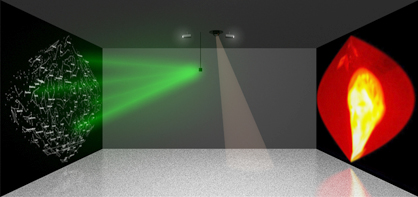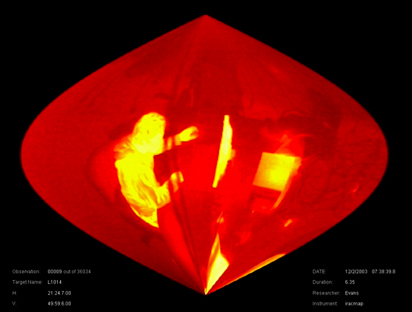| |
|
|

|
Observations Video
|

|
Gallery Camera Video
|
| |
|
| |
|
|
|
| We Are Stardust,
2008 [Click here for Updated Web Page]
Installation, Dimensions Variable
2 screen projection, rotating infrared surveillance camera
“We Are Stardust” is a two-screen projection installation
with infrared camera that maps the sequence of NASA sky observations
from 2003 to the present through the Spitzer Space Telescope,
an infra-red temperature sensing instrument that is orbiting the
sun, and trailing in the earth's orbit.
The intent of the project is to consider the question of how we
imagine our place in space and time at the grand scale, and where
scientists are looking into space. This is realized by visually
mapping the schedule of scientific observations. The schedule,
consisting of data as to what celestial bodies were looked at,
when, for how long, and by whom, provides an overview of the program's
activities.
There are two main visual projections, one representing deep space,
the other the local space of the gallery. The map of the universe
is projected and inscribed with the traces of the Spitzer telescope's
observations. The other consists of an infrared camera's continuous
movements in the gallery that replays the history of the telescope's
movements. By being situated in the exhibition space, it visually
records spectators' thermal presence and actions.
"We Are Stardust" is a commissioned installation artwork
by the Art Center College of Design, and NASA's Spitzer Science
Center’s Education and Public Outreach office, both based in Pasadena.
NASA's Spitzer Space Telescope is a sun-orbiting, infrared observatory,
managed by the Jet Propulsion Laboratory and located on the California
Institute of Technology campus. The installation will be featured
in the "Observe" exhibition at the Art Center College
of Design between October 10, 2008 and January 11, 2009, and will
then move to the Sprengel Museum in Hanover, Germany.

"We Are Stardust" installation lay-out (Click here for video): Far left projection features
skymap markings representing space locations were Spitzer scientists
have been collecting data. Beam sketches out sequential viewings
of star locations. Fully rotational infrared camera in exhibition
space replays movements of Spitzer telescope viewing of the universe.
Far right projection features what the camera is seeing in the
exhibition space.
| |
Universe Space (Left Screen Animation)

Animation of the map of the universe inscribed with the traces
of the Spitzer telescope's observations (Click on image)
|
InfraRed Camera (Right Screen)

Animation of the infrared gallery visualization (Click on image)
|
Spitzer Telescope
The Spitzer telescope was launched on Monday, 25 August, 2003,
from Cape Canaveral Air Force Station. It follows a rather unusual
orbit, heliocentric instead of geocentric, following Earth in
its orbit, and drifting away from Earth at approximately 0.1 astronomical
unit per year (a so-called "earth-trailing" orbit). The primary
mirror is 85 cm in diameter, f/12 (i.e. the focal length is 12
times the diameter of the primary mirror) and made of beryllium
and cooled to 5.5 K. The satellite contains three instruments
that will allow it to perform imaging and photometry from 3 to
180 micrometers, spectroscopy from 5 to 40 micrometers, and spectrophotometry
from 5 to 100 micrometers.
Telescope
Information | Spitzer
Hardware | Spitzer
Orbit | Current
Telescope Location
|
Mapping the NASA Data
Spitzer
Telescope Schedule | Spitzer
Science Center Statistics of the ROC | Map
Projections
|
The 3 Spitzer Infrared Instruments
Infrared
Array Camera (IRAC) | Multiband
Imaging Photometer (MIPS) | Infrared
Spectrograph (IRS)
|
Infrared Camera
FLIR
Indoor Thermal Camera | D-Series
Thermal Dome Camera | What
Is Infrared?
|
Andres Burbano links
Galaxy
Visualizations | Millenium
Movement Simulation | Logarithmic
Map | Google
Sky Spitzer
|
Project Production Team
George Legrady, artist, project manager; Andres
Burbano, artist, researcher; Javier Villegas, project engineer,
infrared and 3D visualization; Tyler Beckert, 3D visualization.
|
Sponsors
“We Are Stardust” is sponsored by the NASA’s
Spitzer Science Center, California Institute of Technology;
Williamson Gallery,
Art Center College of Design, Pasadena; UC Santa Barbara Faculty
Senate Research Grant; Media
Arts & Technology, UCSB; The
University of California Institute for Research in the Arts;
and FLIR Systems.
|
|
| George Legrady (c) 2008 |
|
|
|
|
|
|
|




